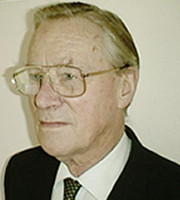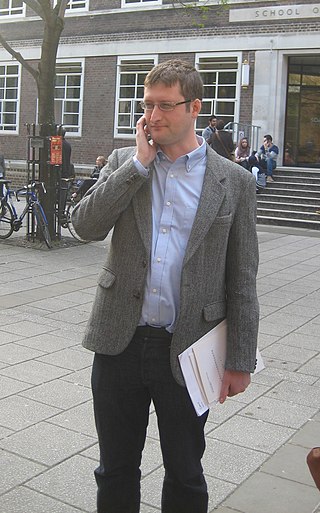Related Research Articles

Evolutionary linguistics or Darwinian linguistics is a sociobiological approach to the study of language. Evolutionary linguists consider linguistics as a subfield of sociobiology and evolutionary psychology. The approach is also closely linked with evolutionary anthropology, cognitive linguistics and biolinguistics. Studying languages as the products of nature, it is interested in the biological origin and development of language. Evolutionary linguistics is contrasted with humanistic approaches, especially structural linguistics.

In grammar, the ergative case is the grammatical case that identifies a nominal phrase as the agent of a transitive verb in ergative–absolutive languages.
Linguistic typology is a field of linguistics that studies and classifies languages according to their structural features to allow their comparison. Its aim is to describe and explain the structural diversity and the common properties of the world's languages. Its subdisciplines include, but are not limited to phonological typology, which deals with sound features; syntactic typology, which deals with word order and form; lexical typology, which deals with language vocabulary; and theoretical typology, which aims to explain the universal tendencies.

A creole language, or simply creole, is a stable natural language that develops from the process of different languages simplifying and mixing into a new form, and then that form expanding and elaborating into a full-fledged language with native speakers, all within a fairly brief period of time. While the concept is similar to that of a mixed or hybrid language, creoles are often characterized by a tendency to systematize their inherited grammar. Like any language, creoles are characterized by a consistent system of grammar, possess large stable vocabularies, and are acquired by children as their native language. These three features distinguish a creole language from a pidgin. Creolistics, or creology, is the study of creole languages and, as such, is a subfield of linguistics. Someone who engages in this study is called a creolist.
Historical linguistics, also termed diachronic linguistics, is the scientific study of language change over time. Principal concerns of historical linguistics include:
- to describe and account for observed changes in particular languages
- to reconstruct the pre-history of languages and to determine their relatedness, grouping them into language families
- to develop general theories about how and why language changes
- to describe the history of speech communities
- to study the history of words, i.e. etymology

Dyirbal is an Australian Aboriginal language spoken in northeast Queensland by the Dyirbal people. In 2016, the Australian Bureau of Statistics reported that there were 8 speakers of the language. It is a member of the small Dyirbalic branch of the Pama–Nyungan family. It possesses many outstanding features that have made it well known among linguists.
In linguistic typology, ergative–absolutive alignment is a type of morphosyntactic alignment in which the single argument ("subject") of an intransitive verb behaves like the object of a transitive verb, and differently from the agent of a transitive verb. Examples include Basque, Georgian, Mayan, Tibetan, and certain Indo-European languages. It has controversially also been attributed to the Semitic modern Aramaic languages.
In the field of dialectology, a diasystem or polylectal grammar is a linguistic analysis set up to encode or represent a range of related varieties in a way that displays their structural differences.
Laki is a vernacular that consists of two dialects; Pish-e Kuh Laki and Posht-e Kuh Laki. Laki is considered a Kurdish dialect, by most linguists and is spoken chiefly in the area between Khorramabad and Kermanshah by about one million native speakers.
Robert Malcolm Ward "Bob" Dixon is a Professor of Linguistics in the College of Arts, Society, and Education and The Cairns Institute, James Cook University, Queensland. He is also Deputy Director of The Language and Culture Research Centre at JCU. Doctor of Letters, he was awarded an Honorary Doctor of Letters Honoris Causa by JCU in 2018. Fellow of British Academy; Fellow of the Australian Academy of the Humanities, and Honorary member of the Linguistic Society of America, he is one of three living linguists to be specifically mentioned in The Concise Oxford Dictionary of Linguistics by Peter Matthews (2014).
A diaphoneme is an abstract phonological unit that identifies a correspondence between related sounds of two or more varieties of a language or language cluster. For example, some English varieties contrast the vowel of late with that of wait or eight. Other English varieties contrast the vowel of late or wait with that of eight. This non-overlapping pair of phonemes from two different varieties can be reconciled by positing three different diaphonemes: A first diaphoneme for words like late, a second diaphoneme for words like wait, and a third diaphoneme for words like eight.

Dan Sperber is a French social and cognitive scientist and philosopher. His most influential work has been in the fields of cognitive anthropology, linguistic pragmatics, psychology of reasoning, and philosophy of the social sciences. He has developed: an approach to cultural evolution known as the epidemiology of representations or cultural attraction theory as part of a naturalistic reconceptualization of the social; relevance theory; the argumentative theory of reasoning. Sperber formerly Directeur de Recherche at the Centre National de la Recherche Scientifique is Professor in the Departments of Cognitive Science and of Philosophy at the Central European University in Budapest.
Michael Hammond is an American linguist and professor at the University of Arizona. He was head of the Department of Linguistics from 2001 to 2011. He is the author or editor of six books on a variety of topics from Syntactic Typology, The Phonology of English, to Computational linguistics. He is known for his research on meter and poetics. He has also published more than 40 articles and presented at over 60 conferences on these topics. He serves on the editorial board of several major journals.
Lahnda, also known as Lahndi or Western Punjabi, is a group of north-western Indo-Aryan language varieties spoken in parts of Pakistan and India. Its validity as a genetic grouping is not certain. Terms like Lahnda or Western Punjabi are exonyms employed by linguists, and are not used by the speakers themselves.

Ellen Contini-Morava is an anthropological linguist, interested in the meanings of linguistic forms, discourse analysis, functional linguistics and (noun) classification; in particular, in the relationship between lexicon and grammar. She specializes in Bantu languages in general, and Swahili in particular.

Frank Robert Palmer was a British linguist who was instrumental in the development of the Department of Linguistic Science at the University of Reading.
Maria “Masha” Polinsky is an American linguist specializing in theoretical syntax and study of heritage languages.

Nathan Wayne Hill is an American historical linguist and Tibetologist specializing in languages of the Sino-Tibetan family, in particular Tibetic languages.
Alireza Korangy Isfahani is an Iranian-American literary critic, philologist and linguist. He is currently faculty at the American University of Beirut. He was previously an Assistant Professor at the University of Virginia. Korangy also taught at the University of Colorado at Boulder. He is the editor-in-chief of the International Journal of Persian Literature and is known for his works on Persian poetry.
Noel Burton-Roberts is a British linguist and Emeritus Professor of English Language and Linguistics at Newcastle University. He is known for work ranging over general and English linguistics: architecture of language, semantics, pragmatics, philosophy of language, and English grammar.
References
- ↑ Bynon, Theodora; Bynon, Professor of Historical Linguistics Soas Theodora (15 September 1977). Historical Linguistics. Cambridge University Press. ISBN 978-0-521-29188-0.
- ↑ Bynon, Theodora (1979). "The Ergative Construction in Kurdish". Bulletin of the School of Oriental and African Studies, University of London. 42 (2): 211–224. doi:10.1017/S0041977X0014577X. ISSN 0041-977X. JSTOR 615012. S2CID 153447165.
- ↑ "Book review".
- ↑ Haspelmath, Martin (1996). "Review of Approaches to Language Typology". Journal of Linguistics. 32 (2): 513–517. doi:10.1017/S0022226700016005. ISSN 0022-2267. JSTOR 4176380. S2CID 144800272.